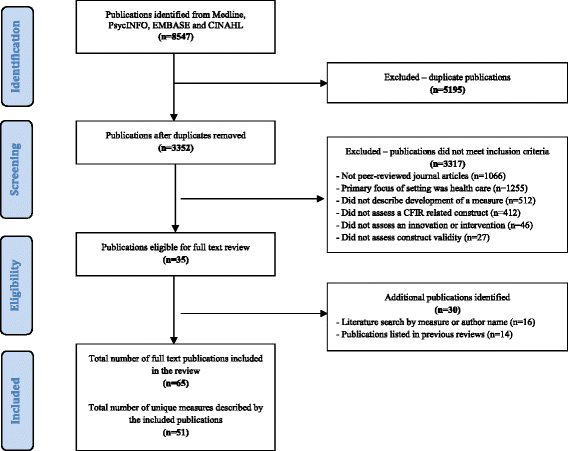Psychometric properties of implementation measures for public health and community settings and mapping of constructs against the Consolidated Framework for Implementation Research: a systematic review
- PMID: 27821146
- PMCID: PMC5100177
- DOI: 10.1186/s13012-016-0512-5
Psychometric properties of implementation measures for public health and community settings and mapping of constructs against the Consolidated Framework for Implementation Research: a systematic review
Abstract
Background: Recent reviews have synthesised the psychometric properties of measures developed to examine implementation science constructs in healthcare and mental health settings. However, no reviews have focussed primarily on the properties of measures developed to assess innovations in public health and community settings. This review identified quantitative measures developed in public health and community settings, examined their psychometric properties, and described how the domains of each measure align with the five domains and 37 constructs of the Consolidated Framework for Implementation Research (CFIR).
Methods: MEDLINE, PsycINFO, EMBASE, and CINAHL were searched to identify publications describing the development of measures to assess implementation science constructs in public health and community settings. The psychometric properties of each measure were assessed against recommended criteria for validity (face/content, construct, criterion), reliability (internal consistency, test-retest), responsiveness, acceptability, feasibility, and revalidation and cross-cultural adaptation. Relevant domains were mapped against implementation constructs defined by the CFIR.
Results: Fifty-one measures met the inclusion criteria. The majority of these were developed in schools, universities, or colleges and other workplaces or organisations. Overall, most measures did not adequately assess or report psychometric properties. Forty-six percent of measures using exploratory factor analysis reported >50 % of variance was explained by the final model; none of the measures assessed using confirmatory factor analysis reported root mean square error of approximation (<0.06) or comparative fit index (>0.95). Fifty percent of measures reported Cronbach's alpha of <0.70 for at least one domain; 6 % adequately assessed test-retest reliability; 16 % of measures adequately assessed criterion validity (i.e. known-groups); 2 % adequately assessed convergent validity (r > 0.40). Twenty-five percent of measures reported revalidation or cross-cultural validation. The CFIR constructs most frequently assessed by the included measures were relative advantage, available resources, knowledge and beliefs, complexity, implementation climate, and other personal resources (assessed by more than ten measures). Five CFIR constructs were not addressed by any measure.
Conclusions: This review highlights gaps in the range of implementation constructs that are assessed by existing measures developed for use in public health and community settings. Moreover, measures with robust psychometric properties are lacking. Without rigorous tools, the factors associated with the successful implementation of innovations in these settings will remain unknown.
Keywords: Factor analysis; Implementation research; Measure; Psychometric; Public health.
Figures
References
Publication types
MeSH terms
LinkOut - more resources
Full Text Sources
Other Literature Sources
Miscellaneous


